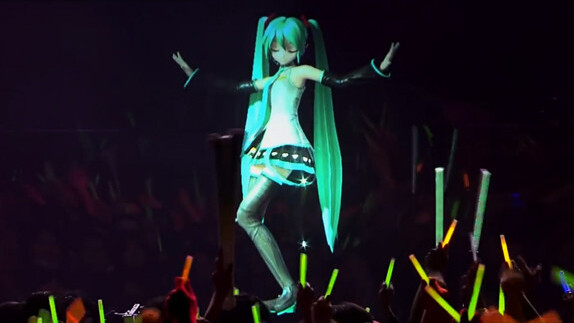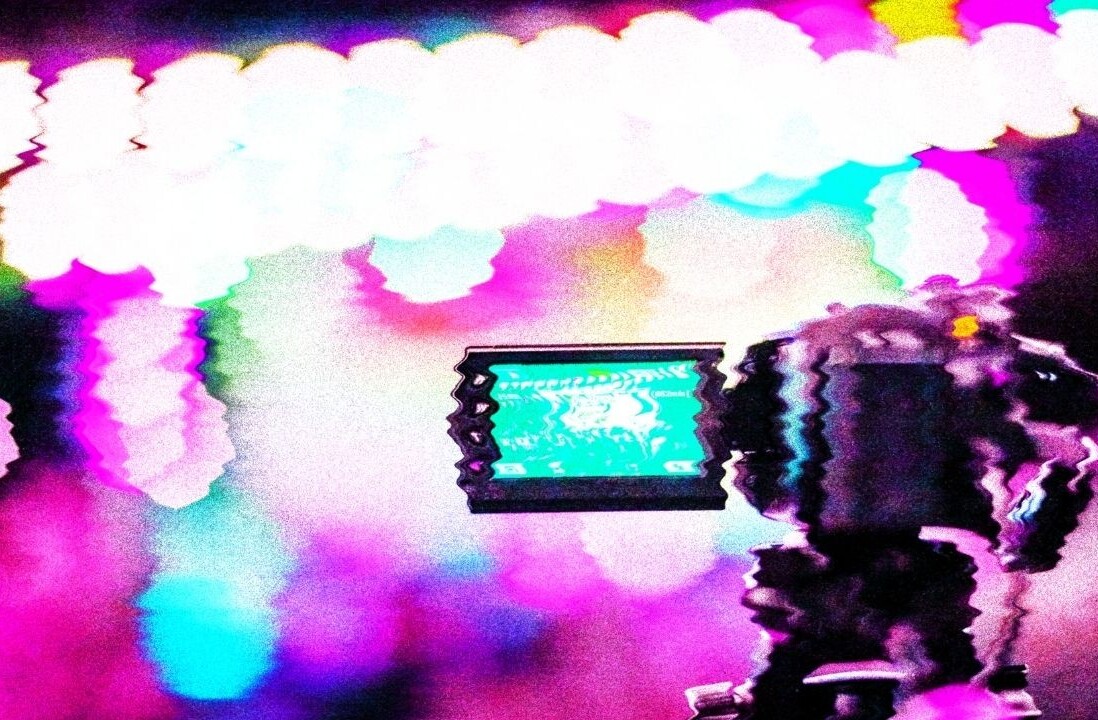
Doug Levy is a staff copywriter and editor for the Shutterstock blog. This post was originally published on the Shutterstock blog and has been reprinted with permission.
Last week, mainstream America — and David Letterman — was introduced to one of Japan’s most intriguing phenomenons, the virtual star known as Hatsune Miku. Making a holographic appearance as the musical guest on the Late Night host’s show, Miku was joined by a live band to perform a song chosen specifically for special live performances in the US this month.
If it all left Dave (and others) a bit confused, it’s not without reason: Miku is much more than just an animated star in the vein of Gorillaz. Rather, she’s a representation of the evolution of digital music technology, crowdsourcing, and creative collaboration.
Technically, Hatsune Miku is a program — a vocal synthesizer called a Vocaloid, developed by Japanese software company Crypton Future Media. She’s not the only one, but she is the most popular, with a rapidly growing fan base worldwide. Anyone can buy the Vocaloid and use it to create songs; everything Miku performs live was created by members of a burgeoning global community, with tens of thousands of songs featuring her voice uploaded since its launch in 2007.
Over 4,000 of those songs are now commercially available via Miku’s record label, Karent, and her avatar has even opened for Lady Gaga on tour.
To help make a little more sense of it all, and to get all the details on Miku’s 2014 Expo, which brings her to a New York stage this weekend in conjunction with an NYC gallery exhibition, we spoke with Cosima Oka-Doerge, US/EU Marketing Manager at Crypton Future Media.
https://www.youtube.com/watch?v=qA5pIpdQEr0
Shutterstock: Do you find it difficult to explain who/what Hatsune Miku is to people who aren’t familiar with her?
Cosima Oka-Doerge: Oh yes, definitely. Most of the reactions people have when they first see or hear about Miku are very biased, but once we have the chance to start explaining what Hatsune Miku really is and how it started out, we get very positive reactions. There’s a lot to explain and it’s difficult to cut something down to a simple answer.
Miku is a new concept in so many ways: as a music program and virtual singing synthesizer; as a projection on stage performing with a live band; as an interface for people to communicate their creations; as a collectively constructed pop star; the list goes on.
It takes a long time to establish these new notions, and even longer for others to process them. We’ve been focusing on finding the right wording for explaining Hatsune Miku, in the hope that people will understand the background of this whole story and not only focus on the most obvious outcome, which is the concert performances.
When the avatar was first created, did anyone expect her to become the phenomenon she is today?
That’s difficult to say, but we at least expected that the software itself would have an impact that goes beyond our usual target of music producers. In 2007, the technology for voice synthesis had improved immensely, already creating quite a buzz among music producers. But with the character illustration, and actually giving the voice of the software a face, we hoped to give the software a broader audience, which really worked out and enabled users to get inspired and to create new artworks around Hatsune Miku.
Another factor for the fast growth of Miku’s popularity was that, in 2007, many video sharing services were emerging, so creators had places where they could present their music and videos to the whole world. We knew there was something new happening when we saw that on the same day of the release in 2007 — a couple of hours later, actually — there were already songs uploaded to the internet and shared. It started evolving into a subculture within a couple of days, with people making remixes of the songs, illustrating Hatsune Miku in their own style, and making music videos.
We were very aware of this development, and reacted by building a free content-sharing site in Japan, piapro.jp, that aims at being a platform where users can upload their creations (instrumental music, vocal data, lyrics, illustrations, CG models) and easily find partners for collaborations. That was a huge factor for the fast growth of Hatsune Miku followers.
What do you think Hatsune Miku’s success says about the future of music, art, and collaboration?
This is a very interesting question. I think it says that the world has changed in terms of how we perceive and consume content, from a relatively receptive audience to an active-participatory one.
When Miku was released, it immediately tapped into this newly arising consciousness, and I believe it filled the blank spot that was missing in this vastness of “being connected” with the whole world: the factor of having a joint interface for mutual collaborations, of actual realization and output of the new awareness of bottom-up, instead of top-down, structures of creation and the music business itself. Miku inspired so many around the world, really becoming an icon for this movement, where creation is available for everyone.
What’s the main goal of the expo? Is the focus still on selling the software, or has it gone beyond that? How do you measure the success of your marketing efforts?
The expo serves the established US fan base of Miku, but also creates the opportunity for a broader audience to get to know Miku and especially what has evolved around it over the past couple of years. The concerts provide a good outlook on the music side, whereas the expo part — the huge fan gathering in LA with cosplay contests, Miku karaoke contests, live paintings, and DJ event, and the art exhibition in NY — show the whole palette of other aspects of the Miku culture.
If the understanding of Hatsune Miku, and the culture that is involved, becomes more understood, the number of fans will also rise — for some, it might be out of pure fandom, while for others it might be out of an admiration of the movement evolving around Miku. Either way, it will also create more demand for products featuring Hatsune Miku, and this is of course where we, as a business, hope to measure the success of our efforts. Nevertheless, as a music software company, we will of course continue developing new software, technologies, and ways of presenting content. It’s not without reason that the company is called Crypton “Future Media.”
Is Hatsune Miku more popular with creators or with general fans now? Do you feel any need to manage how she’s presented in the media?
I would say that she is equally popular among creators and fans. Also, the culture around Miku is so complex and versatile that it’s even hard to draw a line between who are the fans and who are the creators. We have the most amazing comments from young people around the world, often describing that although they weren’t interested in art or any sort of creation until now, with Miku they developed a curiosity, a desire of wanting to create something. Now we have all these amazing people finding something they are good at. It has really no limit. In addition to music and illustrations, we have fans and creators posting their videos of special Miku dance moves, even cooking with Miku — all sorts of lifestyle areas are covered. Being a fan or creator in the Miku culture, it’s quite a blurry line, I think.
With the sheer amount of content created using the character, how do you sort through it all when you’re deciding what to spotlight?
It is a crazy amount. We only manage by knowing where and how to look. For example, we look up what’s popular in the community by the number of views on NicoNico or YouTube, reading comments, and then considering which songs work well together for the whole setlist of a concert. This includes the collaborative artworks between the various users, like illustrations and costume designs that go along with the songs, which works nicely for presenting Miku in various styles throughout the show.
What’s the most impressive or unexpected thing you’ve seen someone do with the character?
There are so many amazing artworks with Miku, it’s hard to pin it down to a single one. Basically, it covers any area in which artists would create new works — music, illustration, stage presentations, dance moves, 3D modeling and so much more. There’s even a whole opera made with Hatsune Miku that traveled to Paris and was on stage in the famous Théâtre du Châtelet. It’s called The End: A Vocaloid Opera by Keiichiro Shibuya.
How did Miku end up as the opening act for Lady Gaga’s tour? Did that go as planned, and can we expect to see more appearances like that?
Her management contacted us. We were lucky, since we had thought for a while that it was a very good fit with the Lady Gaga crowd. And then we got this great offer! Of course we’re not sure what will happen in the future, but if we feel that the audiences have a common ground, it can be fun to have Miku tour more!
What has the audience for Miku been like outside of Japan?
Over the years, we have had all sorts of reactions. The younger generations seem to be more open to her appearance and the technology involved, while elder generations are a little afraid that the Hatsune Miku concept is attempting to “replace” traditional singers. The American audience has started to understand that Miku is not only about music, but that it is the whole community and creative inspiration that she represents — that there is more going on than just the voice synthesizer and projection of her on stage. We hope that the Miku Expo event and especially the exhibition at New York’s Wallplay gallery can help highlight and explain this part of Hatsune Miku more, to help people understand Hatsune Miku not merely as a virtual singer, but as a collective movement that is going on.
Is Hatsune Miku more popular than the other Vocaloids simply because she came first? Or is there something that you think makes her special/unique?
Hatsune Miku was the first Vocaloid of the more advanced second engine of the Vocaloid technology, so it’s not the first Vocaloid ever. However, this second generation of the Vocaloid engine had the quality of sounding very real, so I would say that it definitely played a part in why people were starting to actually use the technology actively.
I would also say that the voice that was picked for Hatsune Miku is very unique; among thousands of voices you can tell that it is Miku. The original voice is a recorded voice from Japanese voice actress Saki Fujita, which was then put into the database that makes up the software voice of Hatsune Miku. Another factor is the character design, the blue hair and pigtails — that hadn’t been there before, and therefore had an immense recognition value.
How elaborate is the setup required to bring Hatsune to life in the real world?
It’s actually quite simple: the voice is generated by the software, so vocal data that has been created by the original individuals is being played back. A live band performs to the voice as if it was a real singer. For the projection, it’s computer graphics that are projected with a very strong projector onto a special acrylic board. I would say that the most effort is going into the overall presentation of the show and the graphics.
What advice would you offer to creators who are new to using Vocaloids and unsure how to get started?
I’d like to let them know that it is really easier to use than it seems. Everyone who can use a computer well can understand the principles of the software. Over the past years, we have also developed a simple editor called Piapro Studio that made it even easier to get started with entering melodies and lyrics and have them sung back by the synthesized voice. There are also lots of tutorials around the internet, but I’d say that it is easiest to just dive into it without thinking too much. The rest will come later — the software reveals itself to its users through the duration of time you spend with it.
What does the future hold for Hatsune and the other Vocaloids? Where do you see the characters and the technology going next?
As for Crypton’s side, we will certainly continue working on the software, improving it, and researching various media and technologies to push the technology forward. Concerning the movement that evolved surrounding Hatsune Miku, we really hope that Miku and our other characters will continue inspiring users, as well as fans, to share their ideas and creations, and help foster Miku further as a culture of their own. Our task here is to support the movement and continue to give people new ways of presenting themselves.
Get the TNW newsletter
Get the most important tech news in your inbox each week.






